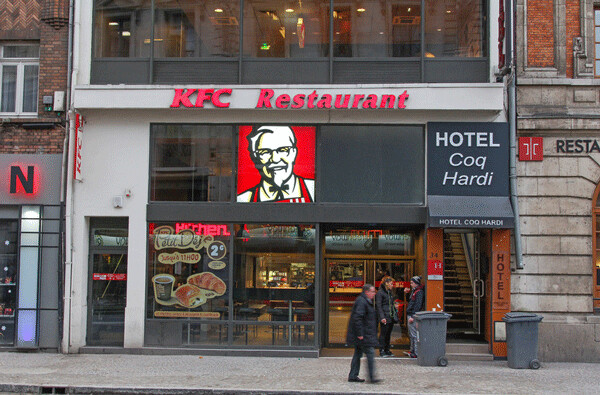News & Articles
Browse all content by date.

I am not going to do a review or guide. What would be the point? I think, instead, general observations make better sense. There is a general pattern. An old European city has a core with a square and cathederal showing elaborate detail of past times. In one square the feature might be gilding. In another carvings or a carrilon clock is a key feature of the square where you can sit with a thousand others for a quaint experience in food or drink before scuttling off to the familiar ground of a friendly hotel. Streets leading away from each square are totally unfriendly to a typical MN pickup which would scrape along and not find a place to park except atop other vehicles. Eventually as the central area is left behind the streets open considerably and would accommodate my pickup.
As you reach a highway the sense of “Europe” grows more American as modern roads appear to grow versions of the strip mall industrial scene familiar in the US and all but dominant from a car.As you whoop along at 180 kph toward the next city center the countryside is much a blurr but with some elements standing out much the way the spires of different Dutch towns mark space, territory, and identity.You can tell there is a difference (near impossible to define in precise terms here) that mark homes and buildings near Calais, Brussels, Antwerp, or Dusseldorf, etc., but my overall impresion is that the modern highway has transformed and largely destroyed the past. There might be a classic looking old house or other building, but it will be surrounded by a low swamp of glittery plastic buildings in the EU and Ikea styles. If the US invented urban ugliness then others have perfected it to a dazzling height.
I am tempted to bewail the ugly impact of the highway where golden arches and the KFC have grown up; invasive American weeds on the plains of Flanders, The Netherlands, and Baltic Poland. But it is clear modrn Europe would not function without fleets of transport trucks wearing the term Logistics (EU Normal for eighteen wheeler). Logistics fills an entire lane where they truck forward at speeds set by EU rule. If a truck is marked 60 kph that is its maximum with consequences for driver and company if the truck runs at 70. Cars in comparison rule the other lanes with blazing speed, especially along the autobahn where a high hp flier will rip by at 200 if the traffic allows. It seems truckers are not pushed to deliver quickly and unlike in the US have accepted a more sedate pace. This is seen much when there’s a delay and traffic halts for long periods. I sat near two hours in one. At the end there was no notion of what caused the delay (accident or conjestion causing breakdown). There were no emergency vehicles to be seen. It seemed as if a sanitizing crew swept up any and all evidence of whatever caused the problem. In the UK an hour long delay was from heavy rain causing a tree to hang onto a roadway. Removal of the tree was the least part of the road closure which lasted and lasted while every last twig, leaf, and wood chip was swept up followed, it seemed, by a tweeser crew making sure there wasn’t a ssmidge of a sign left. This is very thorough indeed, but not what I’d think of as efficient.
While I doubt the modern world would endure many days withought highspeed roads for our cars and trucks, I also can’t help see how these impact and in ways destroy the nature of the land. Where screens are (understandably) used to muffle road noise the experience is one of being in a topless tunnel with no view and scant perspective. Of course it’s just as bad if you’re driving alongside a solid wall of slower moving transport trucks. Nothing to see here. Keep moving. The resulting impression from being rushed from a cluster of narrow streets, rondos, and quaint city centers through a suburban mall sprawl to reach the next old city center is beyond my power to describe without bias. How do you move gracefully from a 14thcentury town square to a strip mall withoug feeling out of whack or as an old seaman might put it “all ahoo”? Does a city center carillon make up for all the outlying ahoo of modernity or should a person forget the old centers and enjoy the brassy exterior of current accomplishment? Don’t look to me for answers. I’m not entirely sure why I wanted to trek back to Europe, but being here I feel confronted with questions and can’t help squirm with the imprrssion that the American version of progress has become a version of industrial, commercial, and societal flu for which there is no vacinne except to turn back the clock, a tactic that has yet to work well even for those who resist daylight savings.
The real question might be how much the hectic and unpleasant aspects of progress come to impact our lives. Or is it how much we allow this happen? I’d ask anyone to name their favorite 600 foot communications tower. We generally rely on them quite a lot, but which do we think attractive or appealing? But I’d bet mostg readers can conjure in the mind an image or feel of a pleasant place they knew with green grass, running water, a sandy beach, or similar “human” size features making it pleasantly appealing. And if there is a question might there then not be a challenge in deciding it is up to each of us to make the effort to bring our humanity and human understanding into the land of techno progress where a smile and civiilty can act as counterbalance to the ungentle side of progress delivered in overnight batches to masses who often believe nature able to deliver more than it can.
It’s easily possible to tuen this into a plea for conserving the past, but the present realities are no way simple and easy as that. What’s a proper measure for a classic eity center if it becomes a venue to overcharge its visitors? Interesting as may be, is old Brussels a place of value because an ancient storefront offers a slim selection of sneakers starting at 1,625 going to 6,520 EU or a coffee on the square cost three times normal? Exploitation can be wrapped many ways. Some simply look nicer while carrying the same ugliness inside.
| Tweet |


